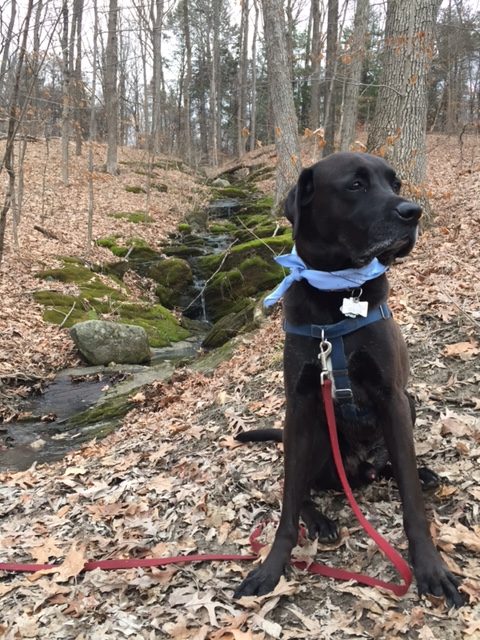I’ve used this mix for three years now in upstate NY (updated Nov. 2019)—the world epicenter of Lyme—hiking daily with my 80-lb lab/Dane mix.
I’m posting this in memory of my teacher, master astrologer Dawn Bogrodi, who passed away after living with undiagnosed Lyme disease for years.
If it’s helpful to you, use this and feel free to share it. As I understand it, the EPA in 2018 instituted stricter rules regarding the essential oils it considers “exempt” from regulation, and the oils in this recipe—although they’re in fact safer and more effective than those the EPA has approved—are not on its current list, meaning it is likely not appropriate to sell commercially.
To use this spray, in general, spray lightly but liberally before going outside. I apply this 2-3x/day to my dog and myself before our walks, which seems to work well for ticks and mosquitoes. I designed it to basically be safe to use as much as you want (see safety note)—more frequent applications will discourage the tiny bugs that like to fly into your eyes. Reapplying at least every 3-4 hours seems safest for repelling ticks, though it may in fact work for 4-6 hours and retain some efficacy (~40%) into the following day or so, according to studies of the essential oils in this spray.

Safety note
Experts in aromatherapy generally agree the oils used in this mix are safe for children over age 2 as well as dogs (for very small dogs, 15 lbs or less, apply lightly and carefully monitor reaction at initial use). For children younger than 2, you can try spraying the outside of their shoes, pants, or other clothing, such as hats or coat sleeves, while they are not in the room, then let the clothes air out for a minute or two before dressing kiddo. Try to do this shortly before going outside. Please do not use this directly on cats. They will inevitably ingest it while cleaning themselves, which could have serious adverse consequences, particularly over time. Women who are pregnant or wish to become pregnant should replace the juniper berry in this formulation with a definitively pregnancy-safe essential oil (see further notes below about this point).
Sourcing
I’ve used Piping Rock and Plant Therapy. Both are affordable, but Plant Therapy is likely higher quality and provides chemical makeup info, which is rare among EO companies, though whether sourcing is entirely responsible does seem vague.
More expensive sources that make strong claims about ethical sourcing, if they’re in your budget (worth calculating the cost for an entire season, which ultimately could end up quite low depending on use): Aromatics International, Sunrose Aromatics, Lotus Garden, and Mountain Rose Herbs.
Bulk Apothecary is a great resource for just about everything except the essential oils in this recipe—though I’ve found their oils to be generally high quality, personally I do prefer to know chemical makeup info, so would not buy essential oils for this there. NOW, available on Amazon, is another affordable brand for things like vitamin E and vegetable glycerin.
Most likely oils from any responsible supplier will work fine. Choose according to your budget and preferences.
The recipe
This recipe makes one 64 oz. batch at a roughly 2% essential oil concentration. This one batch lasts most of the summer for us. Two batches easily last a full season (roughly March-November) before temps drop below 30 degrees, when ticks disappear to burrow underground.
Essential oils
- ~325 drops/16.25 ml lemon eucalyptus (Corymbia citriodora)
- ~325 drops/16.25 ml juniper berry (Juniperus communis)
- ~70 drops/3.5 ml lemongrass (Cymbopogon)
- ~33 drops citrus aurantium dulcis, aka sweet orange (even though it’s a tiny amount, this effectively repels bees that otherwise seem to love lemon eucalyptus: don’t leave it out. Make sure to use this strain; other strains of orange essential oil will be phototoxic, meaning they increase sunburn in sun).
Other ingredients (additional information in parentheses)
- 2 oz. witch hazel (Thayer’s unscented; mild emulsifier)
- 1 oz. castile soap (Bronner’s unscented baby castile soap; mild emulsifier)
- ~1/4 oz. (~8 ml) vegetable glycerin (moisturizer and mild emulsifier)
- ~1-second squirt of aloe vera gel (Lily of the Valley; includes a small amount of important preservatives; also a mild emulsifier)
- 30 ml (1 oz.) fractionated coconut oil^^
- 30 ml (1 oz.) almond oil^^
- 1 dollop (1/2 oz.) vitamin E (antioxidant and moisturizing, with some preservative qualities)*
- ~250 ml (~8 oz.) liquid aloe*
- Distilled water to fill (available in any grocery; don’t use tap or even filtered)
- * optional ingredients: these are not essential to repellency, but help make the spray skin-soothing.
- ^^ almond oil and coconut oil have been shown in studies to have some degree of tick-repellency. I’ve also heard this directly from people who use them and would know, like landscapers. I do notice the spray seems most effective when I include them—and they’re good for skin! Make sure to use fractionated coconut oil: sometimes labeled MCT, this is the kind that’s LIQUID at room temperature—you can find it in most groceries next to standard coconut oil, and definitely at natural food stores; the kind that’s solid will not mix well at all, and can also clog pores.
Directions
I use big, 64-oz glass Bell jars. They seal well and keep in the fridge for months, and shake very easily when the cap is on tight. Then I pour the spray into smaller 4-oz PET plastic or glass bottles for daily use as needed. Do refrigerate this Ball jar, for safety, to prevent mold/bacteria growth; I have not found it necessary to refrigerate the daily use bottles, since we go through them each within a week or two at most.
1) Add essential oils to bottle, counting out drops using a dropper or the bottle with a reducer. This takes the longest of any part of the process, but being tick-free is worth it!
- To make this easier I’ll count out and note what 25 drops looks like from a dropper, then closely approximate the total 325 drops using that eye level. At 25 drops/pull, this will equal 14 squirts from the dropper at the initial measured eye level.
- Important safety note: with essential oils, it is always better to err on the side of less is more—please do not be tempted to use more than a 2 percent concentration, which is the level considered safest for skin application among aromatherapists, especially if you’re using this on kids or small animals. They are powerful, and work remarkably well at 2%!
2) Add castile soap, witch hazel, and aloe vera gel to Bell jar. Shake very well for a minute or two. Let this sit for 5-15 minutes. I’m usually in a hurry, but you could let it sit longer, up to 24 hours. I haven’t found it makes a real difference, either way, how long it sits past the 15-minute mark at this emulsification phase.
3) Add coconut and almond oils, glycerin, and vitamin E. Shake well again several times to mix.
4) Add liquid aloe vera, then distilled water to fill jar, leaving enough room at top (I use the top marked line) to be able to shake and mix well. Store in fridge until ready to use.
Use
Shake Ball jar well for a minute or so before pouring into smaller bottles. Also shake any bottle you’re using immediately before application. The emulsification is imperfect but avoids any questionable ingredients—which I prefer—so it must be shaken well before use or pouring.
Funnels help pouring from the Ball jar into smaller bottles—I have metal ones from Amazon but plastic should work fine. Metal is best, but if you do use plastic funnels, wash immediately after use (essential oils will dissolve plastic over time), unless you happen to know the plastic is PET, which is the one plastic safe to use with EOs. Also be careful with essential oils on any surface except metal! They can ruin a countertop or ceramic sink. Wash your hands often.
Ingredients: A little more info
The oils and ingredients in this recipe come from my own research. The overall scent is fresh, non-gender-specific, and lemony.
Lemongrass seems to be powerful against many bugs; if you leave it out, mosquitoes will likely be quite happy to hang out. If you’re dealing with particularly intent mosquitoes, try adding an additional drop of lemongrass per 1 oz. to this recipe (4 drops for a 4-oz. bottle).
The sweet orange has nothing to do with ticks or mosquitoes, but if you leave it out of this recipe—my dog and I know from personal experience—bees will love you. And land on you. And maybe never leave. Even the tiny amount listed should keep bees—even carpenter bees!—away; if not, add a tiny bit (3-5 drops/4 oz bottle) more.
I was led to these ingredients because I’m allergic to most trees and grasses (even lemongrass bothers me, but I deal). Juniper berry and lemon eucalyptus do not affect my allergies, and have low allergenic potential in general. For the scientifically inclined, see this study on the use of juniper berry to repel ticks, and this, this, and this on the use of lemon eucalyptus. Do note that juniper berry has shown abortifacient effect in rats; women who are pregnant or trying to become pregnant should replace it with another essential oil. Those who are not allergy-prone can certainly try cedar, which has considerable evidence of efficacy against ticks. But this formulation seems to work well.
As noted, almond and coconut oils are included primarily because, for both, there is evidence their ingredients repel ticks. If you’re dealing with a nut allergy, you can safely leave the almond oil out and double the coconut oil amount instead. They are also great for skin. The fractionated version of coconut oil (liquid at room temp.) will not clog pores.
The oils, vitamin E, aloe, glycerin, and witch hazel in this are very good at soothing heat, bug, or otherwise irritated summer skin. I’ve also heard reports the spray has helped dogs with dry skin stop itching.
Preservation note
The Lily of the Valley brand aloe vera gel has a very small amount of preservatives. They are the only preservatives in this recipe. I have stuck bottles of this in my car for several weeks in summer and never noticed a problem. But the value in pouring into smaller bottles is this: you’ll likely use up your 4 ounces or whatever before mold and bacteria start to grow, which they certainly will, even with distilled water. Please do not pick up a bottle after it’s been sitting out for several months—refrigerate this until use, and after it’s poured, try to use within 2 weeks.
Type of tick repellency
In upstate NY, we do not have Lone Star ticks (yet). This has been tested against ticks is this area (black legged, also called deer, ticks; and dog ticks). My main proof that it works, aside from the important studies mentioned above, is that, when I use it, we never see ticks. When I slack—forget to fill my bottles, so I don’t have enough for a good spray before a walk—ticks appear on my dog, even right on his face, despite his always up-to-date Seresto collar. I myself have never gotten a tick since I started to use it consistently last summer.

This Post Has One Comment
Pingback: My teacher, Dawn Bogrodi: In memoriam -